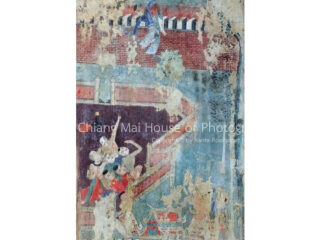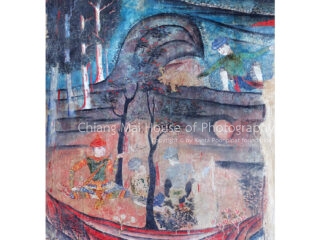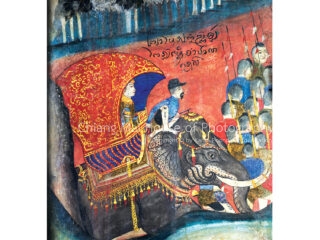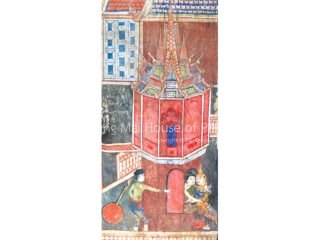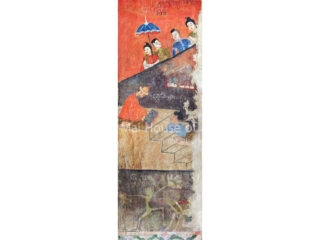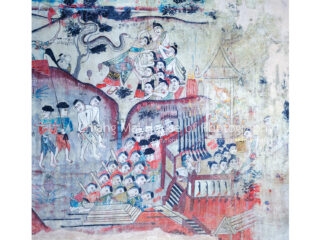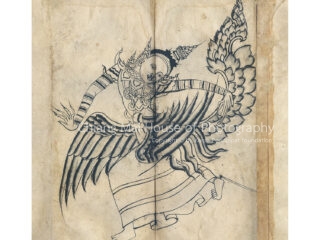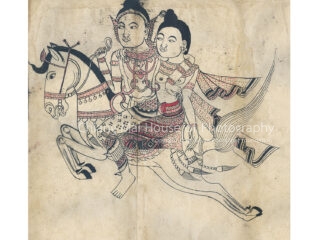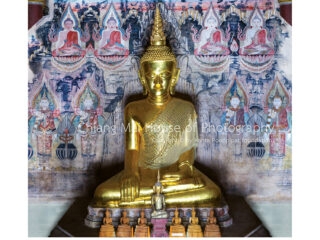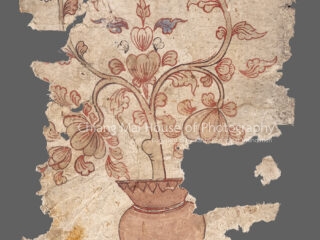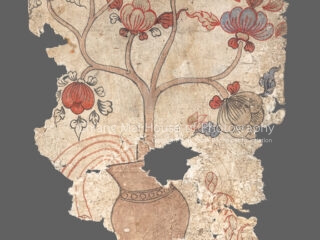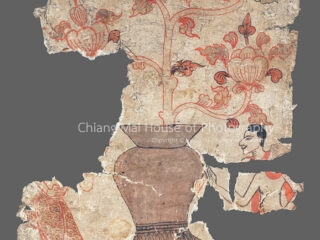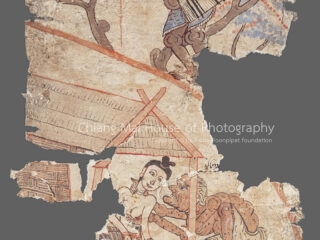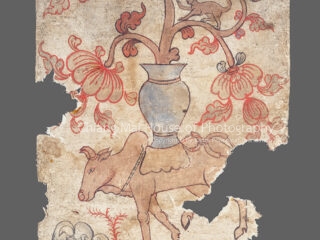The exhibition “Learning from Nan painting” aims to showcase the unique mural artistry of Nan Province, known as the “Nan Artisan Heritage.” These murals are distinctive works of art that set Nan apart from other regions in the Lanna region. The photographs of these murals presented in this exhibition are part of the efforts by the Chiang Mai House of Photography, led by Professor Kanta Poonpipat, to document mural paintings on temple walls and Phra Bot (Buddha images) in Nan Province in digital format. This initiative aims to preserve this cultural heritage for educational purposes and various other dimensions.
The exhibition includes an electronic book (E-Book) titled “Nan’s Murals: Unveiling Nan’s Artisan Heritage,” comprising three volumes:
- Volume One: “Nan’s Murals – Primary School Edition” presents folktales such as “Khattanakumara Chadok” and “Jantaka Chadok” in the form of Japanese manga for elementary school students.
- Volume Two: “Nan’s Murals – High School Edition” delves into the knowledge about mural paintings, their history, and styles in Thailand, neighboring countries, the Upper Northern region (Lanna), and Nan Province. This volume targets high school students.
- Volume Three: “Nan’s Murals – General Public Edition” explores various mural stories such as “Jatthakatha Chadok” from Wat Nong Bua and “Khattanakumara Chadok” from Wat Phumin. It also includes interactive two-dimensional animation and mural art brought to life (Murals Brought to Life of Nan).
All three volumes provide easily understandable content that individuals can learn from independently. These E-Books are available for free download, allowing access to knowledge without any cost.
Wat Phu Min is an ancient temple in Nan Province, Thailand.
It was built around the 21st Buddhist century. During the reign of King Ananda Mahidol, the ruler of Nan City, significant renovations and restoration took place from 1867 to 1875.
The temple’s main hall follows the mandala architectural style, with the sanctuary facing east and west, while the main pagoda is located along the north-south axis. Inside the main hall, the entire four walls are adorned with mural paintings. It is believed that these murals were either created during the major restoration or added later.
The mural paintings in Wat Phu Min have a similar style to those in Wat Nong Bua, Tha Wang Pha District, Nan Province. They are divided into two sections on each side of the hall. The upper part depicts large-scale stories from Buddhist history, while the lower part illustrates local folk tales, including the Katha Guman Chatak (Guman Chatak Chronicles). The murals start from the northern wall and continue to the southern wall of the northern section.
The mural painting style in Wat Phu Min involves covering the entire four walls, with a height of approximately 50 centimeters above the floor, reaching almost to the ceiling. The upper section features large-scale paintings, almost life-sized, which may have been created for better visibility due to the temple’s relative height and the absence of strong artificial lighting in the past. Natural light was available during daytime, and only torches and oil lamps provided limited illumination at night, which might explain the choice of larger paintings for better visibility.
The mural paintings predominantly depict scenes from the “Katha Guman Chatak” chronicles, with occasional depictions of local life in Nan during that era. Nan was thriving in various aspects no less than other cities in the region. The mural paintings serve as valuable historical records and can be used for various research purposes, such as studying the unique weaving patterns of Nan’s textiles. Wat Phu Min’s mural paintings are a source of pride for the people of Nan and reflect the local beliefs in teaching morality, emphasizing good behavior, and preserving the local cultural heritage, making it a unique and irreplaceable treasure.
The mural paintings on the walls of Wat Nong Bua
The mural paintings on the walls of Wat Nong Bua depict stories from the “Jantakakathachadok” and Buddhist history. The story of Jantakakathachadok is an ancient moral fable ranked 11th in the Panyasachadok (Pajchimphak) scripture. People in the northern region commonly refer to it as “Khawatham.” Jantakakathachadok is a moral tale that teaches good moral values to children and young people, such as self-sacrifice for the common good, gratitude, honesty, and compassion.
Mural paintings on the walls of temples hold great value as they reflect the way of life of the people during that era. They also showcase the unique local culture, including clothing styles and more. Furthermore, they provide a space for visitors to imagine and find joy.
Wat Phaya Wat
Wat Phaya Wat is a historical temple located in Mueang Nan District, Nan Province, Thailand. This temple is believed to have been built during the same era as Wat Phaya Wat and dates back approximately 600 years. The name “Wat Phaya Wat” appears in various historical documents, such as “Phongsawadan Lanna” and “Phongsawadan Mueang Nan,” indicating its significance and continuous role as a temple throughout history. The temple is situated within the area known as “Wiang Phaya Wat,” an ancient city along the Nan River to the west.
Wat Phaya Wat boasts several significant archaeological sites, including the Phra That Chedi. It is believed that this chedi was constructed during the early 21st Buddhist century. The architectural style of the Phra That Chedi at Wat Phaya Wat is reminiscent of the early Lanna period. It is thought to have been modeled after chedis from other temples, such as Wat Gu Kut in Lamphun Province.
Inside the temple’s main hall, there are beautiful Lanna-style mural paintings on cloth, known as “Phra Bat,” which were created in 1915. These paintings tell the stories of the “Wessandorn Jataka,” a collection of tales from the Buddha’s previous lives. The murals are arranged in a continuous narrative that spans approximately 982 centimeters. Additionally, the paintings depict the way of life and culture during that era, showcasing clothing, architectural details, and more.

Phra Bat at Wat Na Tao
Wat Na Tao is an ancient temple located in the Sisaket Subdistrict of Nan Nao District, Nan Province. It is one of the oldest temples in Nan and was initially constructed during the early Rattanakosin period. The temple features mural paintings on cloth known as “Phra Bat” or locally referred to as “Tung Kawa,” which is a rare and ancient depiction of Buddhist art.
There is one piece of this ancient Phra Bat, and it holds significant historical value. On the back of the painting, there are inscriptions that provide insights into the history of this artwork. The inscriptions, totaling seven lines, are written in both the Pali language and Thai script. They demonstrate a deep understanding of the Pali language and Buddhist scriptures by the monk who wrote them, known as “Phra Dhammachai.”
According to the inscriptions, the painting was created in the year 1177 of the Chula Sakarat Era, equivalent to 1815. This corresponds to the early Rattanakosin period during the reign of King Rama II and the rule of Prince Somdet Thewaraj, who was the 58th ruler and the 8th ruler of the Thonburi Dynasty. This year also marks the time when renovations and the construction of the temple were completed.
The painting’s format consists of two parts. The first part depicts the upper portion of the Phra Bat and features images of five Buddhist deities arranged in four rows. The practice of depicting these five deities is a belief deeply rooted in the local culture and has been found in other temple murals, such as those at Wat Nong Bua. The second part, located in the lower section of the Phra Bat, portrays stories from the life of the Buddha, including his enlightenment and the first sermon to the five ascetics.

Wat Pa Hat
Wat Pa Hat is a temple located in the Pua District of Nan Province, Thailand. The temple was originally established in the year 1863 Buddhist Era (1863 AD). It is situated to the west of the present-day village of Pa Hat. In the year 1947 Buddhist Era (1947 AD), the area experienced a natural disaster, with flooding and landslides. As a result, the residents had to relocate to a new location and collectively founded the new Wat Pa Hat, which exists today.
Within the temple grounds, there is also a museum, the “Wat Pa Hat Museum,” curated by Phra Khru Nanthachotiwat. This museum serves as a repository for Nan’s local heritage and houses various antiquities, including mural paintings on cloth or “Phra Bat” and local crafts.
The mural paintings on cloth are a notable feature of the temple. These paintings depict stories from the “Wessandorn Jataka,” which is a collection of tales from the Buddha’s previous lives. The paintings are done on sheets of cloth and are displayed in the temple for the community to learn from and appreciate.
One of the significant symbols depicted in the artwork is the “Mortar and Pestle of Prosperity” or “Mao Poo Ron Kot,” which represents the flourishing life and creativity in the local Lanna culture. This mortar and pestle are used in Buddhist rituals as offerings.
Overall, Wat Pa Hat is not only a place of worship but also a cultural and historical center that preserves and shares the local heritage of Nan Province.
This book, “Chiang Mai House of Photography” is one of the books about mural paintings in Nan Province, Thailand.
The multimedia learning resource titled “Murals Brought to Life of Nan” presents content related to the historical background of mural paintings in Thailand’s northern region, particularly in Nan


